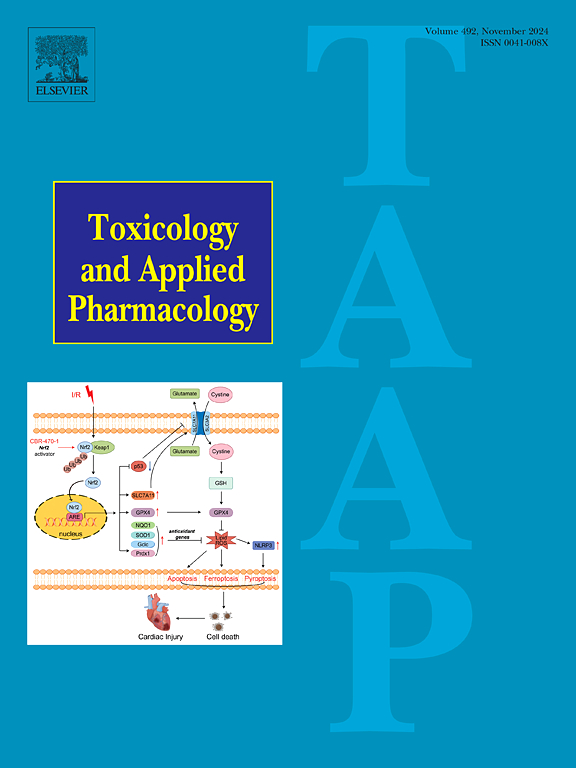鸢尾苷通过抑制去卵巢大鼠NF-κB和凋亡通路对氧化应激的保护作用
IF 3.3
3区 医学
Q2 PHARMACOLOGY & PHARMACY
引用次数: 0
摘要
氧化应激和炎症导致高骨转换,导致绝经后妇女雌激素缺乏引起骨质疏松症。鸢尾花苷是一种具有抗氧化和抗炎特性的类异黄酮,对绝经后骨质疏松模型去卵巢大鼠的保护作用进行了评估。建立5组雌性大鼠(n = 6):正常、OVX对照、tectoridin(10和20 mg/kg bw)治疗的OVX和雌激素治疗的OVX,为期4周。Tectoridin治疗导致体重减轻,股骨重量和厚度增加。治疗后血清E2、钙和磷酸盐水平升高,碱性磷酸酶(ALP)水平降低。此外,鸢尾素通过降低总胆固醇(TC)、甘油三酯(TG)和低密度脂蛋白(LDL),同时增加高密度脂蛋白(HDL)来改变脂质谱。治疗后血清骨特异性碱性磷酸酶(BALP)和I型前胶原n端前肽(PINP)水平升高,骨吸收标志物CTX-1和NTx水平降低。鸢尾花素上调成骨标志物Runx2、Osx和BMP2,表明骨特性增强。此外,它还能降低脂质过氧化,提高超氧化物歧化酶(SOD)、过氧化氢酶(CAT)和谷胱甘肽过氧化物酶(GPx)活性,表明氧化应激降低。鸢尾碱还能抑制炎症蛋白,并对Bax/Caspase3和Bcl2的表达有抗凋亡作用。这项研究强调了鸢尾碱在调节氧化应激、炎症和改善OVX大鼠骨重塑方面的潜力,使其成为治疗绝经后骨质疏松症的候选药物。本文章由计算机程序翻译,如有差异,请以英文原文为准。

The protective effects of tectoridin on bone fractures against oxidative stress via the inhibition of NF-κB and apoptotic pathways in ovariectomized rats
Oxidative stress and inflammation lead to high bone turnover, contributing to osteoporosis caused by estrogen deficiency in postmenopausal women. Tectoridin, an isoflavonoid with antioxidant and anti-inflammatory properties, was evaluated for its protective effects in ovariectomized (OVX) rats, a model of postmenopausal osteoporosis. Five groups of female rats (n = 6) were established: normal, OVX control, OVX treated with tectoridin at 10 and 20 mg/kg bw, and OVX treated with estrogen, over a four-week period. Tectoridin treatment resulted in reduced body weight and improved femur weight and thickness. Serum E2, calcium, and phosphate levels increased, while alkaline phosphatase (ALP) levels decreased after treatment. Additionally, tectoridin altered lipid profiles by decreasing total cholesterol (TC), triglycerides (TG), and low-density lipoprotein (LDL), while increasing high-density lipoprotein (HDL). The treatment elevated serum bone-specific alkaline phosphatase (BALP) and procollagen type I N-terminal propeptide (PINP) levels, and decreased levels of bone resorption markers CTX-1 and NTx. Tectoridin upregulated osteogenic markers Runx2, Osx, and BMP2, suggesting enhanced bone properties. Moreover, it reduced lipid peroxidation and increased superoxide dismutase (SOD), catalase (CAT), and glutathione peroxidase (GPx) activities, indicating reduced oxidative stress. Tectoridin also inhibited inflammatory proteins and exhibited anti-apoptotic effects on Bax/Caspase3 and Bcl2 expression. This study highlights the potential of tectoridin in modulating oxidative stress, inflammation, and improving bone remodeling in OVX rats, making it a candidate for managing postmenopausal osteoporosis.
求助全文
通过发布文献求助,成功后即可免费获取论文全文。
去求助
来源期刊
CiteScore
6.80
自引率
2.60%
发文量
309
审稿时长
32 days
期刊介绍:
Toxicology and Applied Pharmacology publishes original scientific research of relevance to animals or humans pertaining to the action of chemicals, drugs, or chemically-defined natural products.
Regular articles address mechanistic approaches to physiological, pharmacologic, biochemical, cellular, or molecular understanding of toxicologic/pathologic lesions and to methods used to describe these responses. Safety Science articles address outstanding state-of-the-art preclinical and human translational characterization of drug and chemical safety employing cutting-edge science. Highly significant Regulatory Safety Science articles will also be considered in this category. Papers concerned with alternatives to the use of experimental animals are encouraged.
Short articles report on high impact studies of broad interest to readers of TAAP that would benefit from rapid publication. These articles should contain no more than a combined total of four figures and tables. Authors should include in their cover letter the justification for consideration of their manuscript as a short article.

 求助内容:
求助内容: 应助结果提醒方式:
应助结果提醒方式:


